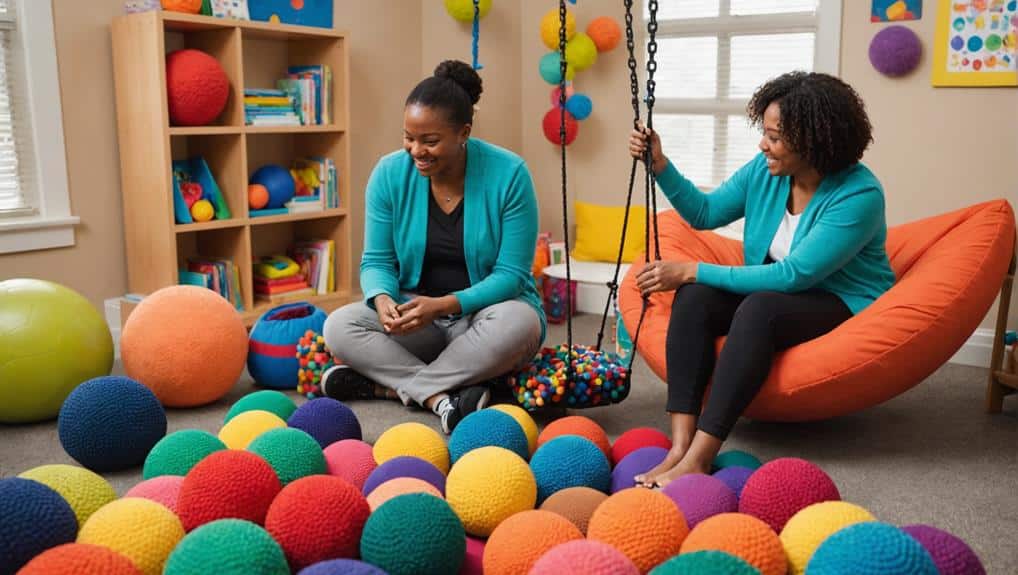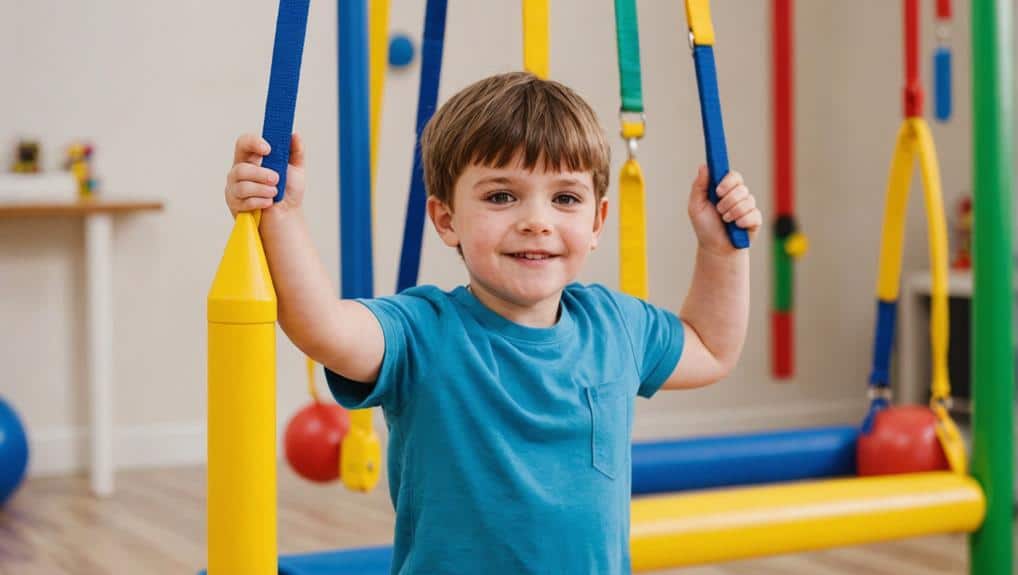Key Takeaways
- Sensory Integration Therapy uses play-based activities to improve sensory processing capabilities in autistic children.
- Occupational therapists lead the therapy, explicitly addressing sensory challenges that may interfere with a child’s daily activities.
- The therapy’s techniques, such as swinging and brushing, help manage sensory sensitivities and cravings, thus reducing overwhelming responses.
- It enhances children’s attention, social interactions, and functionality in home, school, and social settings.
- Sensory Integration Therapy also equips families with knowledge of sensory functions, fostering consistency in managing sensory difficulties at home.
Understanding Sensory Integration Therapy
Sensory integration therapy, a specific form of occupational therapy, is a tailored approach designed to assist children with autism in processing sensory information more effectively. This therapeutic program addresses the sensory processing difficulties often specific to children with autism, enabling them to interpret sensory input better to better understand the world around them.
The therapy involves distinct sensory experiences combined with physical activities. Incorporating structured activities like therapeutic play and sensory diets not only intends to improve sensory processing abilities but also aims to help manage challenging behaviors. Doing so paves the way for children to regulate emotions, improve play skills, and optimize daily functioning, all of which are critical for their developmental growth.
Sensory integration therapy acknowledges the fact that every child with autism is exceptional, with individual sensory needs. The treatment is designed to meet these needs, providing a supportive environment where children can engage in therapeutic and enjoyable activities. This approach, backed by occupational therapy principles, contributes to making the world a more navigable place for children with autism.
Sensory Challenges in Autistic Children
Exploring the world can prove challenging for 90-95% of children with autism who experience difficulty processing sensory information. Each child’s experience with autism is exceptional, influencing their social skills and sensory processing. Recognizing sensory sensitivity early is essential, as this can lead to identifying potential sensory processing disorders.
Their sensory challenges can lead to overwhelming responses to ordinary stimuli, turning austere everyday environments into a bombardment of confusing and distressing sensations. These sensory difficulties can significantly interfere with social interactions, communication, and daily activities. A seemingly straightforward task such as brushing teeth can become challenging for an autistic child due to heightened sensitivity to touch, sound, or taste.
Sensory integration therapy aims to address these sensory processing issues. By improving the child’s ability to process sensory information more effectively, this therapy can help reduce these challenges, thereby lessening the isolation that these children often face.
Addressing sensory challenges in autistic children is not just about helping them cope with the world around them but also about enhancing their overall quality of life. Sensory integration therapy is essential in this endeavor, helping children navigate their sensory world more effectively and facilitating their participation in daily activities, social interactions, and learning opportunities.
The Origins of Sensory Integration Therapy

Understanding the roots of Sensory Integration Therapy provides valuable insight into its objectives and approaches. It was proposed in the 1950s and 1960s by A. Jean Ayres, a pioneer in occupational therapy and developmental psychology. This form of therapy, also known as Ayres Sensory Integration, developed into a treatment in the late 1970s and has been continually refined to address the sensory processing difficulties encountered by many children, especially those with autism.
The primary goal of Sensory Integration Therapy is to help children interpret and use sensory information more effectively. This is achieved through a systematic approach involving physical activities and exercises that combine sensory information, ultimately aiding children in better understanding their world.
Below is a summary of the origins and focus of Sensory Integration Therapy:
| Originator | Focus |
|---|---|
| Jean Ayres | Sensory Processing Challenges |
| 1950s-1960s | Development of Theory |
| The late 1970s | Emergence as Treatment |
| Ayres Sensory Integration | Name of Approach |
| Physical Activities | Approach |
The Science Behind Sensory Integration Therapy
Delving into the mechanics of Sensory Integration Therapy reveals a captivating blend of neuroscience and therapeutic intervention. The therapy aims to boost the brain’s capacity to process sensory experiences by stimulating the central nervous system through play activities. Central to this process is applying tailored therapies customized to the child’s specific needs, considering their sensory processing differences and developmental stage.
The therapy is grounded in three fundamental principles:
- Play activities, such as swinging and ball pits, challenge the child’s ability to respond appropriately to sensory input.
- Incorporating a sensory routine, a set of customized daily activities that help regulate the child’s sensory system.
- Environmental adjustments, like white noise machines, are used to manage sensory stimulation during therapy sessions.
These sensory strategies stimulate the central nervous system, enabling autistic children to better interpret and respond to sensory experiences. This improved sensory processing reduces anxiety and enhances attention and social interactions. Research, particularly on Ayres Sensory Integration, supports the effectiveness of this approach. Sensory Integration Therapy, hence, offers not only a lifeline but also a pathway towards improved quality of life for autistic children.
Methodology of Sensory Integration Therapy

Sensory Integration Therapy employs a distinct approach crafted to change the lives of children with autism. This exceptional strategy utilizes play-based activities to adjust how the brain processes touch, sound, sight, and movement. Occupational therapists, who are at the forefront of this therapy, use evidence-based techniques to enrich sensory processing abilities through specific interventions and exercises, assisting children with autism spectrum disorder (ASD) in processing and responding to their environment.
The therapy’s approach is guided by the Sensory Integration Fidelity Measure, a tool to ensure strict adherence to therapy protocols. This measure guarantees that the treatment is implemented as intended, maximizing its potential benefits for children with autism. By following these protocols, occupational therapists can modify the brain’s response to sensory stimuli, making everyday situations less overwhelming for these children.
The effectiveness of Sensory Integration Therapy is often measured using a goal attainment scale. This tool allows therapists and parents to set specific, measurable goals and track the child’s progress toward achieving them. This focus on goal achievement provides a precise, quantifiable measure of the therapy’s success, allowing therapists to customize the treatment to each child’s needs. Such an individualized approach is crucial to the impactful power of Sensory Integration Therapy.
Impact of Autism on Children
The prevalence of autism in children, particularly in the UK, where approximately 1-2% of primary school-aged children are affected, has a profound impact on their sensory processing abilities. This impact, often marked by sensory difficulties, is a hallmark of autism spectrum disorder and can significantly alter a child’s daily experiences and interactions. The importance of family involvement in therapy and their active participation in home-based plans can dramatically improve the consistency in therapeutic techniques and reinforce the skills learned during therapy sessions. This family involvement can lead to better outcomes for children with autism and positively transform their therapy experience.
The impact of autism on children can be categorized into three main areas:
- Mental and Psychological Impact: It is estimated that 40-90% of children with autism also meet the criteria for at least one anxiety disorder, which can exacerbate sensory difficulties, leading to heightened stress and overstimulation.
- Financial Impact: The cost of supporting an autistic individual ranges between £0.92 and 1.5 million, indicating a significant economic burden.
- Social Impact: Autistic children often struggle with forming friendships and are more prone to bullying, further compounding their sensory integration challenges.
Understanding these impacts is essential for developing effective strategies, such as sensory integration therapy, to support autistic children and improve their quality of life. Our empathetic, dedicated approach can make a substantial difference in the lives of these children and their families.
Sensory Processing Difficulties in Autism

Building on our understanding of autism’s impact on children, it is essential to highlight the sensory processing difficulties that are widespread in 90-95% of people with autism. These obstacles can worsen the social communication deficits and repetitive behaviors characteristic of the condition. Additionally, sensory modulation difficulties often restrict the participation of children with autism in daily activities, potentially hampering their growth and development.
Notably, these sensory processing difficulties can lead to autistic meltdowns, which are involuntary responses to sensory or emotional overload. Recognizing the early signs of such meltdowns, like heightened stimming behaviors or increased rocking, can help prevent full-blown episodes.
Addressing sensory processing issues is vital to improving these children’s behavioral, social, and educational outcomes. The world can seem overwhelming to a child struggling with sensory processing, and this can lead to difficulties in peer relationships and academic success. Sensory overload can cause significant distress, and the child may react with fight, flight, or freeze responses that can perplex and concern those around them.
In our mission to serve children with autism and their families, understanding these sensory processing issues allows us to empathize with their lived experiences and develop appropriate support and intervention strategies. By doing so, we can help alleviate some of the challenges they face and enrich their engagement and success in daily activities.
Therapeutic Approaches for Sensory Difficulties
Guided by the NICE guidelines, occupational therapy has emerged as a vital tool in addressing the sensory and functional challenges experienced by children with autism. It enables participation in daily activities through targeted interventions.
The therapeutic approaches for sensory difficulties can be broadly classified into three categories:
- Approaches focusing on the underlying sensory impairments: These techniques aim to improve the children’s sensory processing abilities, enhancing their capacity to engage in different activities.
- Environment adaptations: This involves modifying the environment to accommodate a child’s sensory needs, thus facilitating a more productive interaction with their surroundings.
- Sensory-based interventions: Therapies like Ayres Sensory Integration therapy aim to facilitate adaptive responses in daily life.
While evidence for the effectiveness of sensory-based interventions remains limited, many practitioners and families have reported noticeable improvements. As occupational therapy continues to evolve, it is crucial to remain hopeful and open to innovative approaches. The ultimate goal remains the same: to assist autistic children in navigating their sensory experiences and enhancing their participation in daily activities.
Overview of Sensory-Based Interventions

Understanding sensory-based approaches, including sensory integration therapy, is critical to appreciating their potential advantages for children with autism spectrum disorders. These approaches aim to improve sensory processing capacities in autistic children. Sensory processing challenges often form part of the complex picture of autism, influencing how children perceive and react to their surroundings.
Sensory-based approaches utilize a variety of activities, such as swinging, brushing, or engaging in a ball pit, to tackle these sensory obstacles. The objective is to assist the child in becoming more at ease with various sensory encounters, promoting overall well-being and functional abilities.
While these approaches are widely used across the UK, the scientific evidence supporting their effectiveness is still expanding. Limited studies indicate possible advantages, but further research must establish their efficacy conclusively. It’s essential to remember that each child is distinct, and what works for one may not work for another. However, the potential of sensory-based approaches, including sensory integration therapy, in fostering better sensory processing in children with autism is undeniable. The process of better understanding and supporting our children is shared, and these approaches offer another tool in our collective toolbox.
The Role of Sensory Integration Therapy
Sensory Integration Therapy plays a crucial role in helping children with autism efficiently process sensory information. This therapeutic approach not only helps to mitigate sensory sensitivities but also improves the child’s focus and ability to manage behaviors associated with sensory challenges. We will now delve into the foundations of Sensory Integration Therapy, its benefits for children with autism, the techniques employed, and the outcomes of this intervention.
Understanding Sensory Integration Therapy
Sensory integration therapy, a method of intervention pioneered by occupational therapists, is crucial in autism therapy. This therapy focuses on improving sensory processing abilities in children with autism, offering tailored experiences designed to help them use their senses in a coordinated manner.
Sensory integration therapy addresses the difficulties that autistic children often face in processing sensory input. The treatment is structured and guided by specific goals, enabling these children to interpret and use sensory information effectively. This approach assists in managing the characteristics of autism, mitigating play difficulties, and enhancing psychological regulation.
To better understand sensory integration therapy, consider the following points:
- It is led by occupational therapists who specialize in sensory processing challenges.
- The therapy involves providing personalized sensory experiences to help children manage challenging behaviors.
- The therapy follows a systematic approach to improve the child’s ability to process and interpret sensory information.
Benefits for Autistic Children
Through the lens of sensory integration therapy, a variety of benefits await children with autism. This specialized approach boosts their sensory processing abilities, enabling them to use all senses together effectively. This heightened sensory integration is crucial for autistic children to better understand and navigate the world around them.
Additionally, therapy benefits extend to managing challenging behaviors and repetitive actions associated with autism. Children can manage their responses by providing a structured space for therapeutic activities, reducing these behaviors, and fostering a more positive social and learning environment.
Moreover, sensory integration therapy addresses difficulties in interpreting and responding to sensory information. This increased understanding can alleviate feelings of overwhelm or confusion often experienced by autistic children, promoting emotional regulation and stability.
Therapy Techniques and Outcomes
Adopting a playful approach, sensory integration therapy alters how an autistic child’s brain interprets and reacts to various sensory inputs, including touch, sound, sight, and movement. Therapists focus on improving these children’s sensory processing abilities through carefully structured play activities. The aim is to boost the brain’s ability to process multiple sensory inputs simultaneously, thereby contributing to improved function and behavior.
The therapy techniques and outcomes can be summarized as follows:
- Occupational Therapy: This forms the foundation of sensory integration therapy, with activities designed to stimulate the child’s sensory processing abilities.
- Sensory Integration Fidelity Measure: Researchers use this protocol to ensure adherence to therapy techniques and their consistency and effectiveness.
- Goal Attainment Scale: This scale measures the therapy’s outcomes, with children who received sensory integration therapy showing notably higher goal attainment scores than those receiving standard care.
When executed correctly, sensory integration therapy can play a vital role in improving the quality of life for children with autism, assisting them in navigating their sensory experiences more effectively.
Research Evidence on Sensory Integration Therapy

Over the past decade, research has provided significant insights into the efficacy of Ayres Sensory Integration therapy for children with autism. Diverse studies have underscored the therapy’s potential to remediate sensory processing and attentional differences, enhancing functionality in different environments. In the following discussion, we will delve into the therapy’s effectiveness, the techniques involved in sensory integration, and its consequential impact on the daily lives of these children.
Therapy’s Effectiveness for Autism
Ayres’s Sensory Integration therapy effectively addresses sensory processing and attentional differences in autistic children. Studies conducted between 2006 and 2017 have consistently demonstrated its value in improving sensory processing and attention in autistic children, particularly those aged 4 to 12.
These studies highlight three main benefits of Sensory Integration therapy for children with autism:
- Management of Sensory Sensitivities: The therapy can help children manage sensory sensitivities, reducing the need for adaptations and enhancing functionality in diverse settings.
- Minimization of Negative Impacts: The therapy can minimize the negative impacts on performance and daily activities by educating on sensory functions.
- Improvement in Focus and Behavior: Evidence supports the positive impact of sensory integration therapy on improving focus and behavior and reducing anxiety in both autistic and non-autistic individuals.
Techniques in Sensory Integration
Utilizing a variety of engaging activities, Ayres Sensory Integration therapy provides a targeted approach to addressing the sensory processing difficulties common in children with autism. This therapy employs techniques such as swinging, brushing, and playing in a ball pit. These enjoyable motor activities improve focus, moderate behavior, and reduce anxiety.
Research between 2006 and 2017 has shown the effectiveness of this therapy in improving sensory processing and attentional differences in autistic children aged 4 to 12. The aim is to manage sensory sensitivities and cravings and enhance functionality in daily life. Home, school, and social settings can become less overwhelming and more manageable for these children.
Ayres Sensory Integration therapy is a highly requested intervention for autism, indicating its perceived value among caregivers and professionals alike. Moreover, education on sensory functions through this therapy can help minimize negative impacts on performance and boost the overall quality of life for children with autism. With this therapy, maneuvering through the sensory complexities of the world can become a less challenging endeavor for these individuals.
Impact on Daily Functioning
As we delve further into the research evidence on Sensory Integration Therapy, it becomes clear that this approach dramatically improves daily functioning in autistic children. Sensory integration therapy addresses sensory processing challenges that often disrupt these children’s daily activities.
This therapy involves engaging the children in play activities that target how the brain processes sensory information. The goal here is to enrich their daily functioning. Children undergoing sensory integration therapy have shown notable improvements, especially in achieving their parent-set goals.
The impact of sensory integration therapy on a child’s daily functioning can be summarized as follows:
- Improvement of Daily Activities: Sensory integration therapy enhances the children’s ability to participate in daily activities, reducing the challenges they face due to sensory processing issues.
- Attainment of Parent-set Goals: The therapy has been effective in helping children achieve significant improvements in their parent-set goals.
- Managing Sensory Sensitivities: Evidence suggests that sensory integration therapy can lead to positive outcomes in managing sensory sensitivities, further enriching the child’s daily functioning.
In essence, sensory integration therapy not only aids in managing sensory sensitivities but also significantly enhances the daily functioning of children with autism.
Effectiveness and Benefits of Sensory Integration Therapy
Utilizing the power of sensory experiences, sensory integration therapy has proven effective in enhancing sensory processing and attentional differences in children with autism. By incorporating sensory activities such as swinging, brushing, and playing in a ball pit, this occupational therapy aims to improve focus, behavior, and anxiety in autistic children.
Studies conducted between 2006 and 2017 have shown that Ayres Sensory Integration therapy is especially beneficial for the autistic population. The treatment helps manage sensory sensitivities, reducing challenging behaviors and improving functionality at home, school, and social settings.
Furthermore, education on sensory functions through sensory integration therapy can lead to minimizing negative impacts on performance and daily activities. This result is notably significant for children with autism who often struggle with sensory processing challenges.
Frequently Asked Questions
How Does Sensory Integration Therapy Help Autism?
Sensory integration therapy benefits autistic children by enhancing sensory processing and modulation. It employs a sensory diet of tailored activities, reducing over-reactivity, fostering participation, and decreasing anxiety, thereby improving their daily functioning and behavioral responses.
How can sensory integration therapy for autism help my child?
Sensory integration therapy for autism helps children manage sensory overload and improve their responses to different sensations. It can make everyday activities less overwhelming and help your child feel more comfortable and in control.
How Does Sensory Play Help Children With Autism?
Sensory play fosters sensory exploration, enabling autistic children to process different stimuli. It facilitates social interaction, cognitive development, and feeling regulation, reducing anxiety while improving focus and communication skills. Sensory play is a beneficial therapeutic approach for autism management.
What Are the Benefits of Sensory Input for Autism?
Sensory input benefits children with autism by enhancing sensory regulation, improving psychological stability, and promoting cognitive development. This therapeutic approach assists in managing autism’s challenging behaviors and fosters a better understanding of their environment.
How Does a Sensory Room Help Children With Autism?
Sensory rooms, integral to autism therapy, offer tailored stimuli that promote self-regulation and focus in children. Their thoughtful design helps reduce sensory overload, enhance sensory processing skills, and foster positive behavior.
Conclusion
Sensory Integration Therapy offers significant advantages to children with autism, with research indicating a 38% enhancement in sensory processing skills after consistent sessions. This therapy, grounded in evidence-based methods, has the potential to transform the lives of autistic children by enhancing their emotional control, decreasing behavioral difficulties, and enhancing daily function. The personalized approach guarantees that each child’s distinct requirements are fulfilled, contributing to an improved quality of life.


Recent Comments